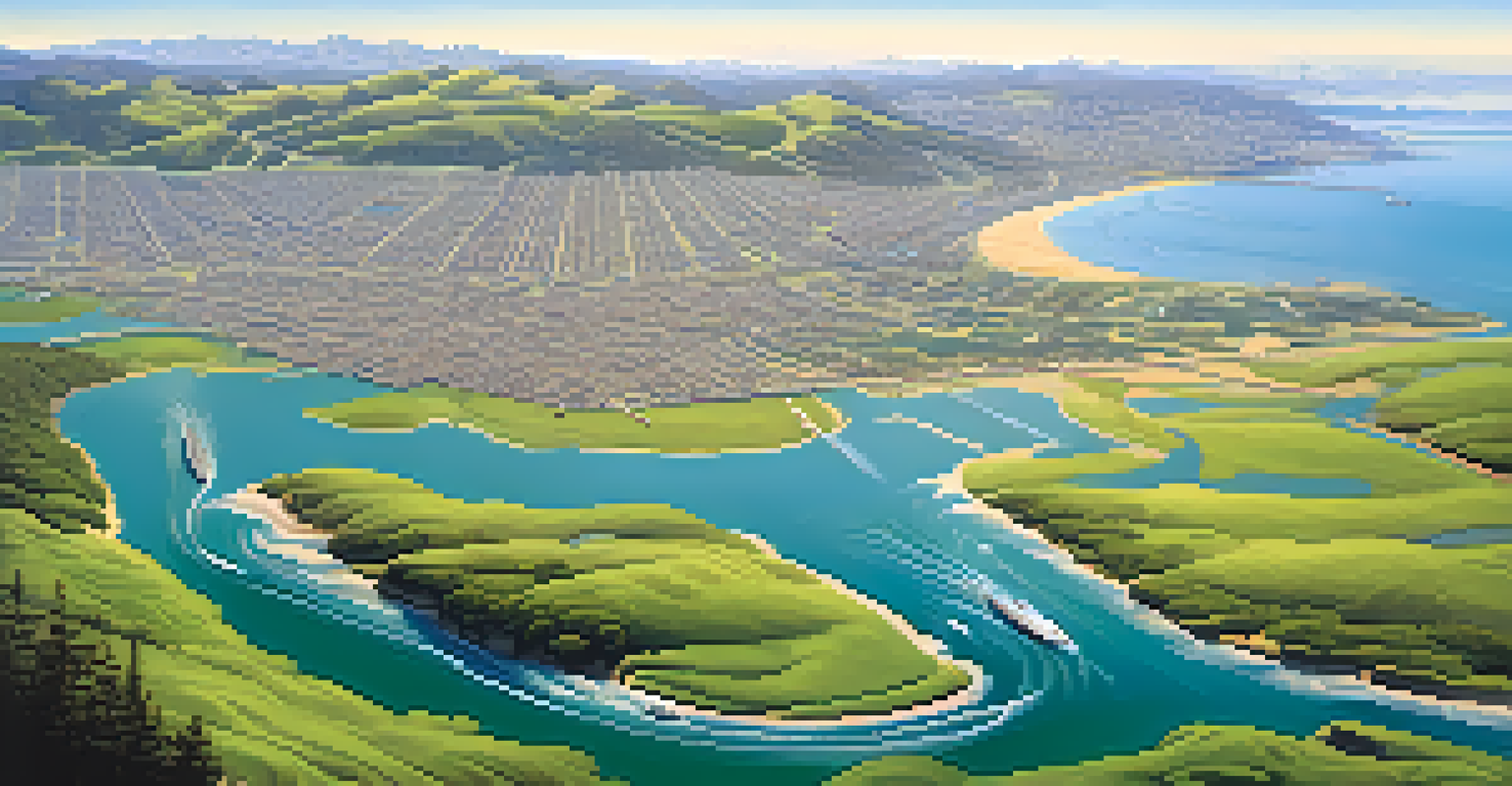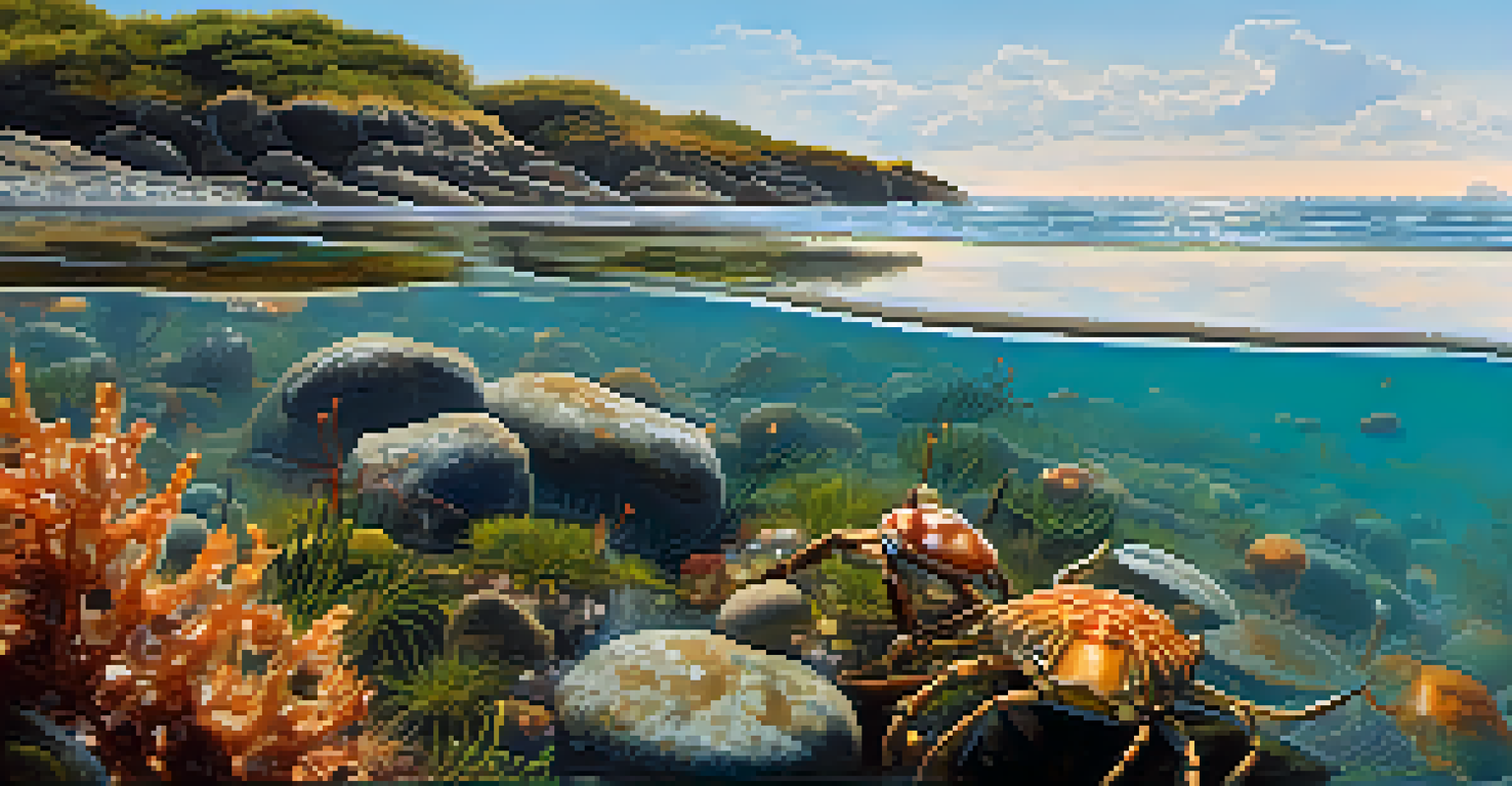The Role of Tides in Shaping San Francisco's Marine Ecosystems

Understanding Tides: The Basics and Their Importance
Tides are the regular rise and fall of sea levels caused primarily by the gravitational pull of the moon and sun. In San Francisco, the tides can vary dramatically, creating dynamic environments for marine life. Understanding these patterns is crucial because they influence everything from nutrient distribution to the behavior of marine organisms.
Tides are the heartbeat of our oceans, shaping the very foundation of marine life.
For instance, during high tides, water covers more areas, allowing various species to thrive in these submerged zones. Conversely, low tides expose tidal flats and rocky shores, which can be harsh environments but are also rich in biodiversity. This ebb and flow create a unique rhythm that shapes the marine ecosystem's structure.
The interaction between tides and coastal geography further enhances this complexity. Features like the Golden Gate Strait funnel tidal flows, amplifying their effects on local marine habitats. As a result, the tides not only dictate when and where marine life can flourish but also play a vital role in the overall health of the ecosystem.
The Influence of Tides on Marine Biodiversity
The diversity of life along San Francisco's coastline is closely linked to tidal movements. Different species of fish, crabs, and mollusks have adapted their life cycles to coincide with the changing tides. For example, many fish spawn during high tides when the increased water coverage provides safety for their young.

Moreover, tidal pools—small bodies of water left behind at low tide—serve as microhabitats for various organisms. These pools can be teeming with life, hosting species like sea stars and anemones that rely on the tidal rhythm for food and reproduction. This rich tapestry of life illustrates how tides support diverse ecological communities.
Tides Shape Marine Ecosystems
The rise and fall of tides, driven by the moon and sun, play a crucial role in influencing marine life and ecosystem health.
However, changes in tidal patterns due to climate change can threaten these delicate ecosystems. As sea levels rise and tidal ranges shift, species that depend on specific tidal conditions may struggle to survive. Protecting these ecosystems means understanding and monitoring the vital role tides play in sustaining them.
Tidal Habitats: Estuaries and Intertidal Zones
Estuaries, where freshwater from rivers meets ocean water, are some of the most productive ecosystems influenced by tides. In San Francisco, the San Francisco Bay serves as an excellent example, providing critical habitats for various wildlife. The changing tides in the bay not only transport nutrients but also create brackish waters that support unique plant and animal species.
The health of our oceans is directly linked to the rhythm of the tides.
Intertidal zones, the areas between high and low tide marks, are equally fascinating. These zones are marked by a constant battle for survival as organisms must withstand both the harshness of the sun and the power of the waves. Species like barnacles and seaweeds have adapted to cling tightly to rocks, showcasing nature’s resilience in these fluctuating environments.
Both estuaries and intertidal zones are essential for the health of the marine ecosystem. They offer breeding grounds, feeding areas, and refuge from predators, highlighting the interconnectedness of tidal movements and marine life. Protecting these areas is crucial for maintaining biodiversity in San Francisco's waters.
Tides and Nutrient Distribution: A Delicate Balance
Nutrient distribution in marine ecosystems is heavily influenced by tidal movements. As tides rise and fall, they stir up sediments and nutrients from the ocean floor, making them available for marine life. This process is vital for sustaining phytoplankton, the foundation of the marine food web, which relies on these nutrients for growth.
In San Francisco, the nutrient-rich waters brought in by tides support a vibrant ecosystem. For example, during specific tidal cycles, phytoplankton blooms can occur, providing food for small fish and ultimately supporting larger predators. This chain reaction underscores the significance of tides in maintaining the intricate balance of marine life.
Human Impact on Tidal Patterns
Urban development and climate change are disrupting natural tidal flows, threatening the delicate balance of marine habitats.
However, human activities, such as pollution and coastal development, can disrupt this natural cycle. As nutrients become more concentrated due to runoff, harmful algal blooms may occur, which can deplete oxygen levels and harm marine life. Understanding the role of tides in nutrient dynamics is essential for protecting and restoring the marine ecosystem.
Human Impact: Navigating the Challenges of Tidal Changes
Human activities have a significant impact on tidal patterns and, consequently, marine ecosystems. Urban development along the San Francisco coastline has altered natural tidal flows, affecting habitats and species that rely on these rhythms. These changes can disrupt the delicate balance that tides maintain in the ecosystem.
Additionally, climate change poses a growing threat, with rising sea levels leading to higher tides and increased flooding in coastal areas. This can result in habitat loss for many marine species and changes in their reproductive cycles. As tides continue to shift, understanding these impacts becomes increasingly important for conservation efforts.
To mitigate these challenges, community engagement and sustainable practices are essential. By promoting awareness of how human actions affect tides and marine ecosystems, we can work together to protect these vital environments for future generations. The health of San Francisco's coastlines is in our hands.
Conservation Efforts: Protecting Tidal Ecosystems
Conservation efforts play a crucial role in maintaining the health of San Francisco's tidal ecosystems. Various organizations work tirelessly to restore habitats, monitor species, and educate the public about the importance of tides. These initiatives are vital for ensuring that both the natural environment and the communities that depend on it thrive.
One notable example includes the restoration of tidal wetlands along the bay, which serve as natural buffers against storms and rising sea levels. By reintroducing native vegetation and allowing tidal flows to return, these projects help to revitalize the ecosystem and support diverse wildlife. The benefits of such efforts extend beyond marine life, contributing to improved water quality and increased carbon sequestration.
Conservation is Essential
Active conservation efforts, including habitat restoration and community engagement, are vital for protecting tidal ecosystems in San Francisco.
Community involvement is also essential in these conservation efforts. Engaging local residents in clean-up activities, educational programs, and citizen science projects fosters a sense of stewardship for the environment. Together, we can ensure that the tides that shape San Francisco's marine ecosystems continue to flow for generations to come.
The Future of Tides and Marine Life in San Francisco
Looking ahead, the future of San Francisco's marine ecosystems hinges on our understanding and protection of tidal dynamics. As climate change continues to impact sea levels and weather patterns, the delicate balance maintained by tides will be tested. Ongoing research and monitoring are crucial to adapt conservation strategies to these changes.
Moreover, fostering a connection between urban communities and marine environments can inspire action. Programs that encourage residents to engage with local waterways can enhance appreciation for the diverse life forms influenced by tides. By nurturing this relationship, we can cultivate a collective commitment to preserving these vital ecosystems.

Ultimately, the tides are not just a natural phenomenon; they are a powerful force that shapes the very fabric of marine life in San Francisco. By prioritizing conservation and sustainability, we can ensure that the tides continue to nourish and support the rich biodiversity that defines this remarkable coastal city.